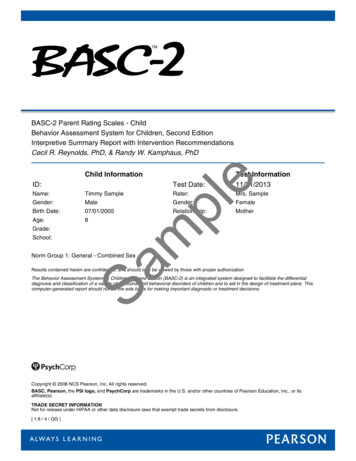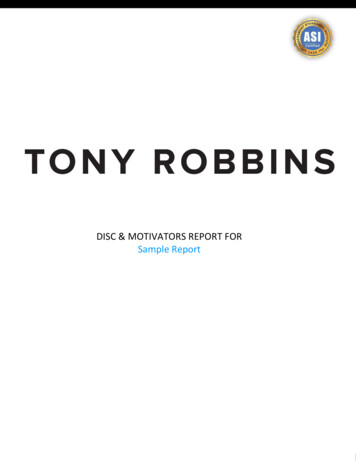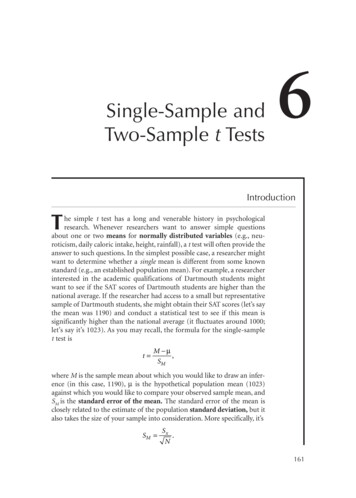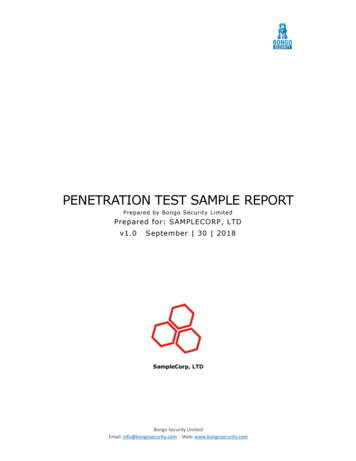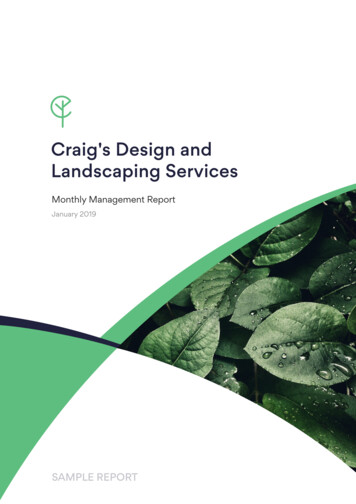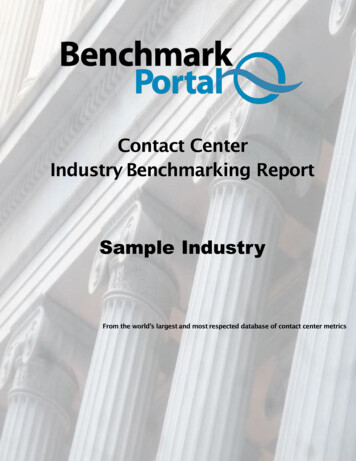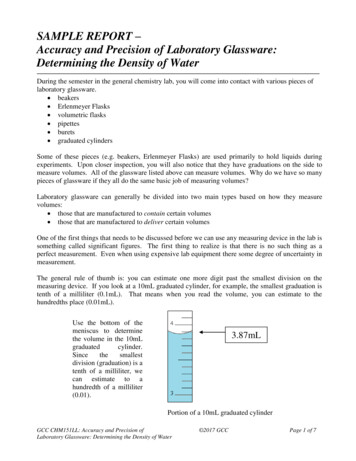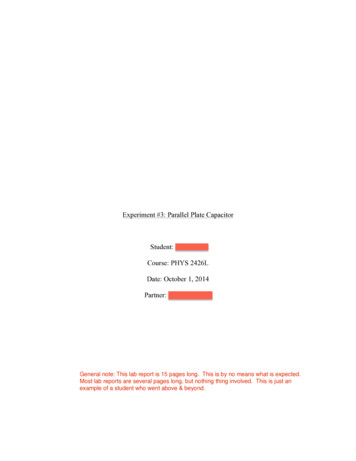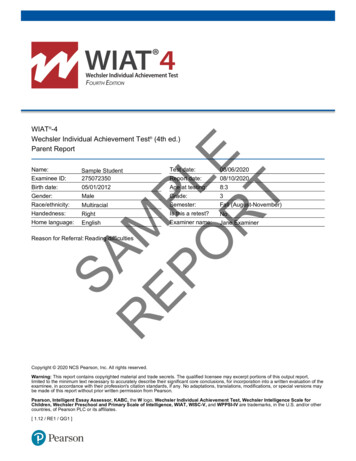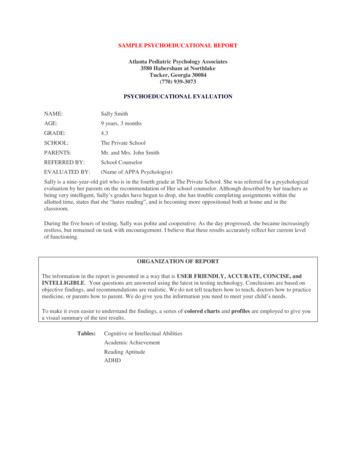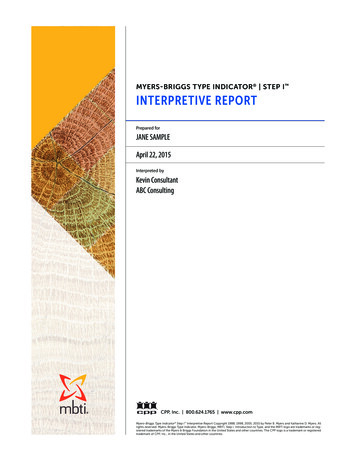
Transcription
MYERS-BRIGGS TYPE INDICATOR STEP I INTERPRETIVE REPORTPrepared forJANE SAMPLEApril 22, 2015Interpreted byKevin ConsultantABC ConsultingCPP, Inc. 800.624.1765 www.cpp.comMyers-Briggs Type Indicator Step I Interpretive Report Copyright 1988, 1998, 2005, 2015 by Peter B. Myers and Katharine D. Myers. Allrights reserved. Myers-Briggs Type Indicator, Myers-Briggs, MBTI, Step I, Introduction to Type, and the MBTI logo are trademarks or registered trademarks of the Myers & Briggs Foundation in the United States and other countries. The CPP logo is a trademark or registeredtrademark of CPP, Inc., in the United States and other countries.
INTERPRETIVE REPORTJANE SAMPLEMYERS-BRIGGS T YPE INDICATOR STEP I ENFP 2About Your ReportYour Myers-Briggs Interpretive Report is designed to helpyou understand your results on the Myers-Briggs TypeIndicator (MBTI ) assessment. This assessment identifiesIMAGINATIVEMOTIVATORwhich of 16 different personality types best describes you.Your reported Myers-Briggs personality typeENFPYour preferencesExtraversion Intuition Feeling PerceivingThe MBTI assessment was developed by Isabel Briggs Myers and her mother, Katharine Cook Briggs, who spent yearsobserving people. They created the assessment based on the personality type theory proposed by psychologist CarlJung. Their goal was to help people understand how natural, healthy differences in the way people take in informationand come to conclusions lead so clearly to the different ways people act and react, make life choices, relate to others,and make sense of the world. These insights help explain why different people are interested in different things, prefervarious kinds of work, and sometimes find it hard to understand each other. The MBTI assessment is now used byorganizations and individuals around the world to improve their interactions and to promote effectiveness in their workand personal lives. Organizations use it to improve communication, teamwork, and leadership. Those entering the work world use it to choose careers likely to match their interests and strengths;those seeking a change use it to target new career directions. Educators and students use it to make learning more interesting and compatible with individuallearning and teaching styles. People in relationships of all kinds use it to better understand one another, improve communication,and reduce conflict, resulting in more positive and productive interactions.Isabel Briggs Myers created descriptions of the 16 personality types, including the description presented for you in thisreport. Your type description will help you see your type’s distinctive characteristics and how your type differs fromothers. The insights gained will help you better understand and appreciate the basic differences between people andmore successfully manage the impact of those differences.
INTERPRETIVE REPORTJANE SAMPLEMYERS-BRIGGS T YPE INDICATOR STEP I ENFP 3Your Myers-Briggs Personality Type: ENFPThe questions on the MBTI assessment are designed so that when you respond to a question, you show which preferencein one of the four pairs of opposites you prefer.EXTRAVERSIONorINTROVERSIONOpposite ways to direct and receive energySENSINGorINTUITIONOpposite ways to take in informationTHINKINGorFEELINGOpposite ways to decide and come to conclusionsJUDGINGorPERCEIVINGOpposite ways to approach the outside worldAlthough each of us can and does use all of the preferences at least some of the time, people typically find one in eachpair more comfortable and natural than its opposite. Think of your choices as something like being right- or left-handed.Both hands are valuable and useful, but most people use the hand they favor naturally more often and become moreadept with it. In the same way, your type preferences are choices between equally valuable and useful qualities. Your ENFPresults are described below.THE WAY YOU DIRECT AND RECEIVE ENERGYExtraversionPeople who prefer Extraversion tend todirect their energy toward the outsideworld and get energized by interacting withpeople and taking action.IntroversionPeople who prefer Introversion tend todirect their energy toward their inner worldand get energized by reflecting on theirideas and experiences.THE WAY YOU TAKE IN INFORMATIONSensingPeople who prefer Sensing tend to take ininformation that is real and tangible.They focus mainly on what theyperceive using the five senses.IntuitionPeople who prefer Intuition tend to takein information by seeing the big picture.They focus mainly on the patterns andinterrelationships they perceive.THE WAY YOU DECIDE AND COME TO CONCLUSIONSThinkingPeople who prefer Thinking typically basetheir decisions and conclusions on logic,with accuracy and objective truth theprimary goals.FeelingPeople who prefer Feeling typically basetheir decisions and conclusions on personaland social values, with understanding andharmony the primary goals.THE WAY YOU APPROACH THE OUTSIDE WORLDJudgingPeople who prefer Judging typicallycome to conclusions quickly and want tomove on, and take an organized,planned approach to the world.PerceivingPeople who prefer Perceiving typicallylook for more information before comingto conclusions and take a spontaneous,flexible approach to the world.
INTERPRETIVE REPORTJANE SAMPLEMYERS-BRIGGS T YPE INDICATOR STEP I ENFP 4Your Type Description: ENFPENFPs see life as a creative adventure full of exciting possibilities. Unusuallyperceptive about people and the world, they are insightful about the presentand future. ENFPs experience a wide range of feelings and intense emotions.IMAGINATIVEMOTIVATORThey need affirmation from others and readily give appreciation and support.ENFPs are innovators, initiating projects and directing lots of energyinto getting them going. They are stimulated by new people, ideas, andexperiences. They readily find meaning and significance in things andLife is full of possibilitiessee connections that others don’t. They are likely to be curious, creative,Enthusiastic, warm, imaginativeENFPs value harmony and goodwill. They like to please others and will adaptMake quick, confident connectionsbetween events and information andproceed accordinglyimaginative, energetic, enthusiastic, and spontaneous.to other people’s needs and wishes when possible. ENFPs tend to makedecisions by applying their personal values while keeping others’ needs inmind. They are likely to be warm, friendly, caring, cooperative, and supportive.They have exceptional insight into possibilities in others and have the energyWant frequent affirmation, readilyto help bring them to fruition.appreciate and support othersENFPs are usually lively, gregarious, and sociable, with a large circle of friends.Spontaneous, flexible, verbally fluent,often rely on their ability to improviseThey are interested in almost everything and have a zest for life that drawsothers to them. At the same time, they value depth and authenticity in theirclose relationships and will go to great lengths to create and support openand honest communication.ENFPs hate routine, schedules, and structure and usually manage to avoidthem. They are normally verbally fluent, even in extemporaneous situations;however, when talking about their deepest values, they may suddenlybecome awkward and express their opinions with uncharacteristic intensity.Others usually see ENFPs as personable, perceptive, persuasive, enthusiastic,spontaneous, and versatile.Sometimes life circumstances have not supported ENFPs in the developmentand expression of their Intuition and Feeling preferences. If they have notdeveloped their Intuition, ENFPs may fail to take in enough information,mistrust their own insights, be uncertain, and accept others’ perceptionstoo quickly. If they have not developed their Feeling, they may go fromenthusiasm to enthusiasm, never committing themselves, or they may makeoverly personal decisions.
INTERPRETIVE REPORTJANE SAMPLEMYERS-BRIGGS T YPE INDICATOR STEP I ENFP 5Your Unique Personality Type: ENFPThe two middle letters of your Myers-Briggs personality type show the two mental processes that make your type unique.THE MENTAL PROCESSESTaking In InformationSENSINGorComing to ConclusionsINTUITIONTHINKINGorFEELINGYour two middle letters are N (Intuition) and F (Feeling). As an ENFP, you devote most of your energy to Intuition andsupport your Intuition with Feeling. Thinking (T) is not as appealing for your type and therefore is much less likely to beused. Least preferred and most rarely used of all is Sensing (S). ENFPs tend to develop Intuition and Feeling during the firsthalf of life, and at midlife they begin to find Thinking and Sensing more interesting and easier to use.The letters of your type also show what others are most likely to notice about you—what you use in the outside worldversus what you reserve for your inner world of ideas and impressions. Here’s how that works for ENFP.You use your favorite process, Intuition, mostly in the outer world of people, things, and activities; this is what people caneasily see when they observe you in action. You use your second process, Feeling, mostly in your inner world of thoughtsand ideas, where others are unlikely to see it. You tend to use your third and fourth processes, Thinking and Sensing,when a situation requires their use but quickly return to what is most natural and comfortable for you, Intuition andFeeling. Sensing is least appealing for you.4 SENSING1 INTUITIONNMost undevelopedUsed most often and isbest developedUsed in the inner worldUsed in the outer worldSF3 THINKINGRelatively undevelopedUsed in either world2 FEELINGTSupports the #1 process andis second in developmentUsed in the inner worldYour type description takes all of the above into account in describing ENFPs in everyday life. Review your descriptioncarefully. Does it match up with your self-knowledge? If the description makes you feel comfortably understood, thenthe Myers-Briggs personality type described for you is likely on target. The description is meant to help you trust anddevelop the preferences that come most naturally to you, while keeping in mind that, like most people, you use all of thepreferences from time to time, depending on what the situation calls for.
INTERPRETIVE REPORTJANE SAMPLEMYERS-BRIGGS T YPE INDICATOR STEP I ENFP 6Clarity of Your PreferencesYour MBTI responses also provide a picture of how clearly or consistently you chose your preference in each pair ofopposites. This preference clarity index (pci) is indicated in the graph below. A longer line suggests that you are quite sureabout a preference; a shorter line means that you are less sure about whether that preference truly describes you. Yourpreference clarity does not indicate how well developed your preferences are or how well you use them.CLARITY OF YOUR PREFERENCES: jMODERATESLIGHTMODERATECLEARVERYCLEAR I FEELING 252015EXTRAVERSION 26105INTUITION 260INTROVERSIONINTUITION 30PCI RESULTS:CLEAR51015FEELING 32025PERCEIVING30PERCEIVING 25Do your assessment results seem to fit? Many find that their type results capture their personality attributes quite well.Others find that changing one or more of the preferences in their four-letter type yields a type description that fits thembetter. If in doubt, consider these suggestions. Think back to your frame of mind when you took the assessment. Did you answer the questions describing whattruly comes most naturally and easily to you? Were your responses perhaps influenced by the situation in which youanswered the questions, or by how you felt you should respond? If your responses did not reflect your natural way ofbeing, then the type description presented for you may not entirely match. Was it hard to decide between the response options for some of the questions? If so, those choices may haveaffected your results and created a mismatch. You will find complete descriptions of all 16 Myers-Briggs personalitytypes in the Introduction to Myers-Briggs Type booklet by Isabel Briggs Myers. Review them with your typepractitioner, who can assist you in finding the type that fits you best.CPP, Inc. 800.624.1765 www.cpp.com Full copyright information appears on page 1.
INTERPRETIVE REPORT MYERS BRIGGS TYPE INDICATOR . JANE SAMPLE ENFP 3 Although each of us can and does use all of the preferences at least some of the time, people typically nd one in each pair more comfortable and natural than its opposite. Think of your choices as something like being right- or left-handed. Both hands are valuable and useful, but most people use the hand they favor .
